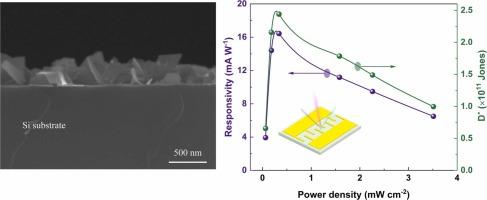利用改良溶热法开发的大尺度独立式 Bi2Te3/Si 异质结构,用于自供电的高效成像光电探测器
IF 5.8
2区 材料科学
Q2 CHEMISTRY, PHYSICAL
引用次数: 0
摘要
拓扑绝缘体碲化铋(Bi2Te3)是一种奇异的量子态物质,在下一代光电器件中具有广阔的应用前景。然而,由于缺乏较大的带隙,Bi2Te3 中的光激发载流子通常会迅速弛豫。本文采用一种低成本的改良两步溶热法,在硅衬底上生长出大规模独立的 Bi2Te3 纳米片,成功合成了高质量的 Bi2Te3/Si 异质结。得益于 Bi2Te3/Si 异质结界面上的内置电场对光生载流子分离和传输的促进作用,Bi2Te3/Si 异质结光电探测器在零偏压下的 470 纳米光照条件下表现出 16.44 mA W-1 的高响应率、2.44 × 1011 Jones 的高比检测率和 11/13 ms 的快速上升/恢复时间。此外,该器件还有可能应用于高分辨率成像。鉴于其整体光敏性能和低成本,溶热法合成的 Bi2Te3/Si 异质结在快速宽带光探测器中具有广阔的应用前景,同时也为在衬底上生长 Bi2Te3 纳米片提供了一条新途径。本文章由计算机程序翻译,如有差异,请以英文原文为准。

Large-scale free-standing Bi2Te3/Si heterostructures developed by a modified solvothermal method for a self-powered and efficient imaging photodetector
Topological insulator bismuth telluride (Bi2Te3), an exotic state of quantum matter, has broad application prospects in next-generation optoelectronic devices. However, photoexcited carriers in Bi2Te3 usually relax rapidly due to the lack of a large band gap. Herein, high-quality Bi2Te3/Si heterojunction is successfully synthesized by a low-cost modified two-step solvothermal method to grow large-scale free-standing Bi2Te3 nanosheets on a Si substrate. Benefiting from the promotion of photogenerated carrier separation and transport by the built-in electric field at the Bi2Te3/Si heterojunction interface, the Bi2Te3/Si heterojunction photodetector exhibits a high responsivity of 16.44 mA W-1, a high specific detectivity of 2.44 × 1011 Jones, and fast rise/recovery times of 11/13 ms under 470 nm illumination at zero bias. Additionally, the device has potential applications in high-resolution imaging. In view of its overall photosensitivity performance and low cost, the Bi2Te3/Si heterojunction synthesized by the solvothermal method has a promising application in fast broadband photodetectors, and also provide a new route for the growth of Bi2Te3 nanosheets on substrates.
求助全文
通过发布文献求助,成功后即可免费获取论文全文。
去求助
来源期刊

Journal of Alloys and Compounds
工程技术-材料科学:综合
CiteScore
11.10
自引率
14.50%
发文量
5146
审稿时长
67 days
期刊介绍:
The Journal of Alloys and Compounds is intended to serve as an international medium for the publication of work on solid materials comprising compounds as well as alloys. Its great strength lies in the diversity of discipline which it encompasses, drawing together results from materials science, solid-state chemistry and physics.
 求助内容:
求助内容: 应助结果提醒方式:
应助结果提醒方式:


